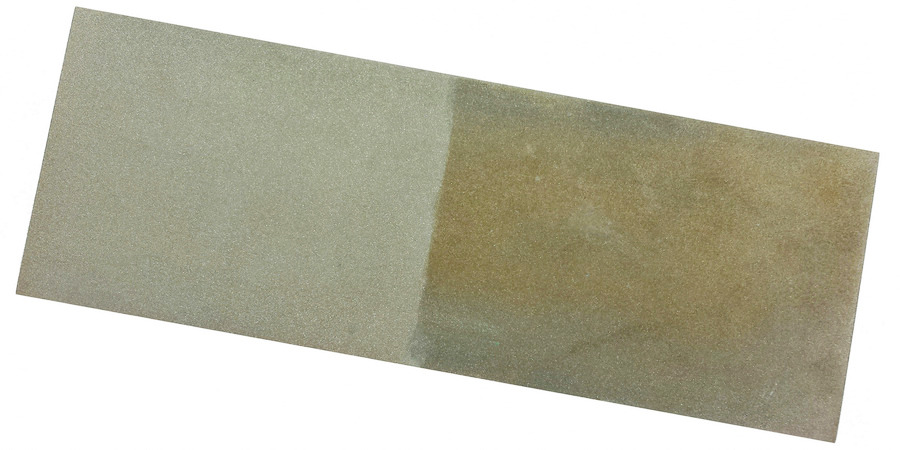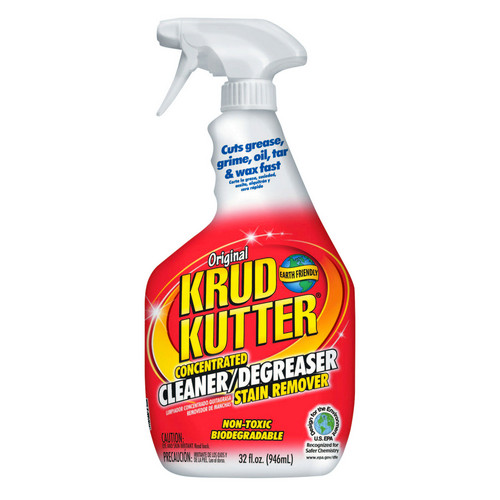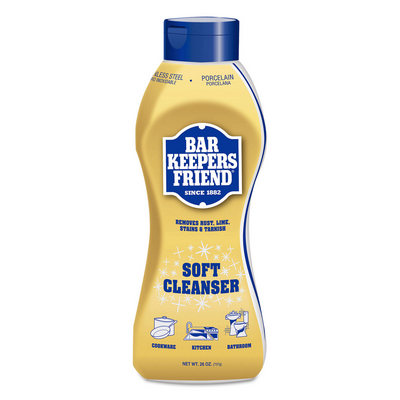Care & Use of Diamond Sharpening Stones

Topics Covered:
- Best Lubricant to Use
- Cleaning Diamond Sharpening Stones
- Removing Rust
- Breaking in a Diamond Sharpening Stone
Best Lubricant to use for Diamond Sharpening Stones
The best lubricant to use for diamond sharpening stones is a product called Krud Kutter. While plain water, windex ect. will work, Krud Kutter is the best lubricant to use for diamond sharpening stones. It is economical and a quart bottle can be purchased at your local Lowes or Home Depot for around $8 and a quart is going to last you a very, very long time. Also, using Krud Kutter for a lubricant makes cleaning your diamond stones very easy.
To lubricate your stone spray enough Krud Kutter on the stone so that it puddles up. As you are sharpening there should be a good puddle in front of your blade as your are moving it back and forth. If the stone starts to dry out simply spray on a little more Krud Kutter and continue sharpening. The most common mistake people make when using diamond sharpening stones is not using enough lubricant.
Keeping a good puddle on the stone prevents the metal shavings from clogging the stone which slows down the sharpening process. Also, If metal shavings from your blade get stuck in the nooks and crannies of the stone, those metal shavings will rust making it appear your stone has rusted. If it appears your diamond sharpening stone has rust, follow the instructions below under the heading How to Remove Rust From Diamond Sharpening Stones. It is a very simple procedure and takes only a minute or two.
Diamond sharpening stones require the least maintenance of all stones but they do need to be cleaned periodically to maintain optimum performance. Below are some simple instructions on how to clean and remove rust from diamond sharpening stones.
How to Clean Diamond Sharpening Stones
To clean your diamond sharpening stones just spray on enough Krud Kutter on the stone so it puddles up. Then, use a nylon brush (like a brush used to clean your fingernails) and scrub the stone. You do not have to scrub real hard or apply a lot of pressure. Just use the brush to work the Krud Kutter down into the nooks and crannies of the stone. You can now rinse them off with warm water. We continue to gently scrub the stone while rinsing to ensure any metal shavings are thoroughly rinsed from the stone. Be sure to allow them to dry before putting them away.
How to Remove Rust from Diamond Sharpening Stones
For real deep cleaning or if they get discolored, use a product called Bar Keepers Friend. It's only a couple dollars and available almost everywhere. Bar Keepers Friend is available in liquid and powder form. Both work just as well but we prefer the liquid form.
First, clean the stones with Krud Kutter as described above and pat them dry with a paper towel. Then, put enough Bar Keepers Friend on the stone so it can be spread evenly over the surface of the stone. Using your nylon brush, spread the Bar Keepers Friend evenly on the stone. Gently scrub the stone with the nylon brush for a minute or two. Rinse the stone off with warm water while continuing to gently scrub with the brush. Any rust or discoloration will be gone and your diamond sharpening stones will be as good as new. Just be sure to allow the stone to dry thoroughly before putting them away.
Breaking In a Diamond Sharpening Stone
Breaking in your diamond sharpening stones is an important step and ensures your stones will provide you many years of service.
Diamond sharpening stones are purposely saturated with diamonds in the manufacturing process. This is done to ensure the diamonds are distributed on the stones as densely as possible. Significant changes occur in the surface of the stones during the break-in as some of the excess diamonds are removed from the stone.
Here are some great images of what's happening to a diamond stone during the break in: Diamond Break-in Part 1 and Diamond Break-in Part 2
There are two important points to remember when breaking in a diamond sharpening stone. 1) There should be a good puddle of lubricant on the stones at all times. 2) You should rinse the stone well periodically to remove any diamond particles that have come loose. Your diamond stone should be fairly well broken in after just a couple of minutes using any of the three methods below. We recommend three methods of breaking in your diamond stone.
We recommend three methods of breaking in your diamond stone.
1. Sharpen as you normally would but use the largest, dullest knife you have. Just be sure to follow the instructions above, keep the stone well lubricated and rinse the stone and knife every minute.
2. Run a piece of steel over the surface. Again, it is important to use plenty of lubricant. Don't use excessive pressure, just pass the steel over the stone for about 30 seconds. Rinse the stone and the steel under running water to be sure you are rinsing off any diamond particle that may have come loose. Repeat the process for another 30 seconds and your stone should be broken in. Don't use a large piece of steel. You want the diamond particles that are dislodged to be immediately rinsed off. If you use too large of a piece of steel the particles that become dislodged will grind into the nickel plating. A piece of steel 1 inch x 1 inch is about right. Again, rinse often.
3. Flatten a water stone as you normally would for 30 seconds to one minute. Use light pressure. This is best done under running water as it is best to continually rinse the stone during this process. (This process is a little aggressive for the 2200 or 3000 grit stones. The 2200 and 3000 are best broken in with one of the two processes above).
Important: Do not try to flatten the back of a chisel or plane blade with a brand new diamond stone. Diamond stones should be well broken in using one of the methods above prior to flattening chisels or plane blades.
Diamond sharpening stones have greatly increased in popularity of the last decade. They sharpen fast, don't need to be flattened and outlast other stones. You can see our diamond stones here Diamond Stones
To read more articles click here Articles
We hope you found this article helpful. If you have questions or comments please contact us.


The best lubricant to use for diamond sharpening stones is a product called Krud Kutter. While plain water, windex ect. will work, Krud Kutter is the best lubricant to use for diamond sharpening stones. It is economical and a quart bottle can be purchased at your local Lowes or Home Depot for around $8 and a quart is going to last you a very, very long time. Also, using Krud Kutter for a lubricant makes cleaning your diamond stones very easy.
To lubricate your stone spray enough Krud Kutter on the stone so that it puddles up. As you are sharpening there should be a good puddle in front of your blade as your are moving it back and forth. If the stone starts to dry out simply spray on a little more Krud Kutter and continue sharpening. The most common mistake people make when using diamond sharpening stones is not using enough lubricant.
Keeping a good puddle on the stone prevents the metal shavings from clogging the stone which slows down the sharpening process. Also, If metal shavings from your blade get stuck in the nooks and crannies of the stone, those metal shavings will rust making it appear your stone has rusted. If it appears your diamond sharpening stone has rust, follow the instructions below under the heading How to Remove Rust From Diamond Sharpening Stones. It is a very simple procedure and takes only a minute or two.
Diamond sharpening stones require the least maintenance of all stones but they do need to be cleaned periodically to maintain optimum performance. Below are some simple instructions on how to clean and remove rust from diamond sharpening stones.
How to Clean Diamond Sharpening Stones
To clean your diamond sharpening stones just spray on enough Krud Kutter on the stone so it puddles up. Then, use a nylon brush (like a brush used to clean your fingernails) and scrub the stone. You do not have to scrub real hard or apply a lot of pressure. Just use the brush to work the Krud Kutter down into the nooks and crannies of the stone. You can now rinse them off with warm water. We continue to gently scrub the stone while rinsing to ensure any metal shavings are thoroughly rinsed from the stone. Be sure to allow them to dry before putting them away.
How to Remove Rust from Diamond Sharpening Stones
For real deep cleaning or if they get discolored, use a product called Bar Keepers Friend. It's only a couple dollars and available almost everywhere. Bar Keepers Friend is available in liquid and powder form. Both work just as well but we prefer the liquid form.
First, clean the stones with Krud Kutter as described above and pat them dry with a paper towel. Then, put enough Bar Keepers Friend on the stone so it can be spread evenly over the surface of the stone. Using your nylon brush, spread the Bar Keepers Friend evenly on the stone. Gently scrub the stone with the nylon brush for a minute or two. Rinse the stone off with warm water while continuing to gently scrub with the brush. Any rust or discoloration will be gone and your diamond sharpening stones will be as good as new. Just be sure to allow the stone to dry thoroughly before putting them away.
Breaking In a Diamond Sharpening Stone
Breaking in your diamond sharpening stones is an important step and ensures your stones will provide you many years of service.
Diamond sharpening stones are purposely saturated with diamonds in the manufacturing process. This is done to ensure the diamonds are distributed on the stones as densely as possible. Significant changes occur in the surface of the stones during the break-in as some of the excess diamonds are removed from the stone.
Here are some great images of what's happening to a diamond stone during the break in: Diamond Break-in Part 1 and Diamond Break-in Part 2
There are two important points to remember when breaking in a diamond sharpening stone. 1) There should be a good puddle of lubricant on the stones at all times. 2) You should rinse the stone well periodically to remove any diamond particles that have come loose. Your diamond stone should be fairly well broken in after just a couple of minutes using any of the three methods below. We recommend three methods of breaking in your diamond stone.
We recommend three methods of breaking in your diamond stone.
1. Sharpen as you normally would but use the largest, dullest knife you have. Just be sure to follow the instructions above, keep the stone well lubricated and rinse the stone and knife every minute.
2. Run a piece of steel over the surface. Again, it is important to use plenty of lubricant. Don't use excessive pressure, just pass the steel over the stone for about 30 seconds. Rinse the stone and the steel under running water to be sure you are rinsing off any diamond particle that may have come loose. Repeat the process for another 30 seconds and your stone should be broken in. Don't use a large piece of steel. You want the diamond particles that are dislodged to be immediately rinsed off. If you use too large of a piece of steel the particles that become dislodged will grind into the nickel plating. A piece of steel 1 inch x 1 inch is about right. Again, rinse often.
3. Flatten a water stone as you normally would for 30 seconds to one minute. Use light pressure. This is best done under running water as it is best to continually rinse the stone during this process. (This process is a little aggressive for the 2200 or 3000 grit stones. The 2200 and 3000 are best broken in with one of the two processes above).
Important: Do not try to flatten the back of a chisel or plane blade with a brand new diamond stone. Diamond stones should be well broken in using one of the methods above prior to flattening chisels or plane blades.
Diamond sharpening stones have greatly increased in popularity of the last decade. They sharpen fast, don't need to be flattened and outlast other stones. You can see our diamond stones here Diamond Stones
To read more articles click here Articles
We hope you found this article helpful. If you have questions or comments please contact us.



